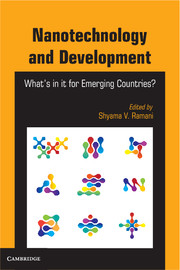Refine listing
Actions for selected content:
881 results in Ebooks in nanotechnology

Introduction to Nanofiber Materials
-
- Published online:
- 05 July 2014
- Print publication:
- 31 July 2014

Nanotechnology and Development
- What's in it for Emerging Countries?
-
- Published online:
- 05 June 2014
- Print publication:
- 28 April 2014
CHAPTER 8 - On India’s Plunge into Nanotechnology
- from Part III - Placing Bets on Nanotech: Case Studies of Emerging Countries
-
-
- Book:
- Nanotechnology and Development
- Published online:
- 05 June 2014
- Print publication:
- 28 April 2014, pp 205-232
-
- Chapter
- Export citation
CHAPTER 1 - On Nanoscience, Nanotechnology, and Nanoproducts
- from Part I - Introduction to Nanotechnology and Participation of Developing Countries
-
-
- Book:
- Nanotechnology and Development
- Published online:
- 05 June 2014
- Print publication:
- 28 April 2014, pp 3-28
-
- Chapter
- Export citation
Index
-
- Book:
- Nanotechnology and Development
- Published online:
- 05 June 2014
- Print publication:
- 28 April 2014, pp 263-268
-
- Chapter
- Export citation
CHAPTER 2 - Learning from Solyndra
- from Part II - Winning and Losing in Nanotech: Case Studies from Developed Countries
-
-
- Book:
- Nanotechnology and Development
- Published online:
- 05 June 2014
- Print publication:
- 28 April 2014, pp 39-72
-
- Chapter
- Export citation
Contributors
-
- Book:
- Nanotechnology and Development
- Published online:
- 05 June 2014
- Print publication:
- 28 April 2014, pp 259-262
-
- Chapter
- Export citation
CHAPTER 7 - NST without NII?
- from Part III - Placing Bets on Nanotech: Case Studies of Emerging Countries
-
-
- Book:
- Nanotechnology and Development
- Published online:
- 05 June 2014
- Print publication:
- 28 April 2014, pp 176-204
-
- Chapter
- Export citation
CHAPTER 3 - How is a Regional Technology Cluster Created?
- from Part II - Winning and Losing in Nanotech: Case Studies from Developed Countries
-
-
- Book:
- Nanotechnology and Development
- Published online:
- 05 June 2014
- Print publication:
- 28 April 2014, pp 73-92
-
- Chapter
- Export citation
List of Tables
-
- Book:
- Nanotechnology and Development
- Published online:
- 05 June 2014
- Print publication:
- 28 April 2014, pp ix-x
-
- Chapter
- Export citation
Part III - Placing Bets on Nanotech: Case Studies of Emerging Countries
-
- Book:
- Nanotechnology and Development
- Published online:
- 05 June 2014
- Print publication:
- 28 April 2014, pp 119-238
-
- Chapter
- Export citation
CHAPTER 4 - Co-Patenting Patterns in Nanotechnology
- from Part II - Winning and Losing in Nanotech: Case Studies from Developed Countries
-
-
- Book:
- Nanotechnology and Development
- Published online:
- 05 June 2014
- Print publication:
- 28 April 2014, pp 93-114
-
- Chapter
- Export citation
Part II - Winning and Losing in Nanotech: Case Studies from Developed Countries
-
- Book:
- Nanotechnology and Development
- Published online:
- 05 June 2014
- Print publication:
- 28 April 2014, pp 37-118
-
- Chapter
- Export citation
Appendices
- from CHAPTER 5 - Sure Bet or Mirage?
-
- Book:
- Nanotechnology and Development
- Published online:
- 05 June 2014
- Print publication:
- 28 April 2014, pp 150-153
-
- Chapter
- Export citation
Appendices
- from CHAPTER 8 - On India’s Plunge into Nanotechnology
-
- Book:
- Nanotechnology and Development
- Published online:
- 05 June 2014
- Print publication:
- 28 April 2014, pp 233-238
-
- Chapter
- Export citation
List of Figures
-
- Book:
- Nanotechnology and Development
- Published online:
- 05 June 2014
- Print publication:
- 28 April 2014, pp vii-viii
-
- Chapter
- Export citation
Appendices
- from CHAPTER 1 - On Nanoscience, Nanotechnology, and Nanoproducts
-
- Book:
- Nanotechnology and Development
- Published online:
- 05 June 2014
- Print publication:
- 28 April 2014, pp 29-36
-
- Chapter
- Export citation
CHAPTER 9 - Nanotech after Biotech in Emerging Economies
- from Part IV - Conclusions
-
-
- Book:
- Nanotechnology and Development
- Published online:
- 05 June 2014
- Print publication:
- 28 April 2014, pp 241-258
-
- Chapter
- Export citation
Dedication
-
- Book:
- Nanotechnology and Development
- Published online:
- 05 June 2014
- Print publication:
- 28 April 2014, pp iii-iv
-
- Chapter
- Export citation
Acknowledgments
-
- Book:
- Nanotechnology and Development
- Published online:
- 05 June 2014
- Print publication:
- 28 April 2014, pp xi-xii
-
- Chapter
- Export citation
